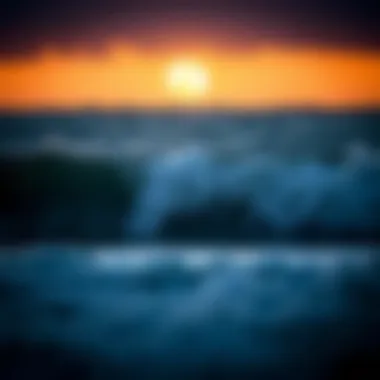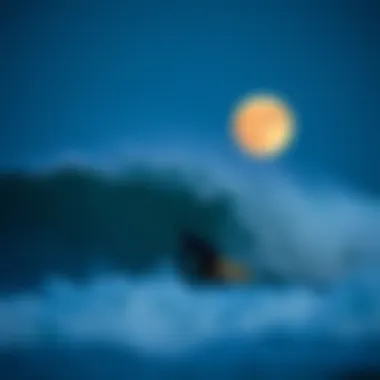Understanding Moon Phases and Surfing Conditions


Intro
The rhythm of the ocean dances with the phases of the moon, and for surfers, this connection is more than just poetic—it’s vital. Understanding how the next moon change influences tidal patterns can significantly impact surf conditions. By knowing what to expect from the lunar cycle, surfers can gear up, plan their trips, and catch those perfect waves. This article will break down the intricate relationship between lunar movements, ocean tides, and optimal surfing experiences.
As the moon waxes and wanes, it orchestrates the swell patterns that surfers rely on. For instance, during full moons and new moons, the tides are typically more pronounced, altering wave formations. In this context, we delve into the significance of these transitions, equipping surfboard enthusiasts—both newbies and those riding the waves for years—with insights that can elevate their experience at sea.
Let’s set the sails and navigate through the components that shape our surfing journeys. From the types of surfboards suitable for your skill level to techniques that can help refine your style, we've got you covered. Let's get into the heart of the matter!
Surfboard Reviews
Choosing the right surfboard can feel like finding a needle in a haystack for many. With countless options cascading down to specific designs catering to different styles and conditions, it's crucial to understand what is out there.
Types of Surfboards: An Overview
Surfboards come in various shapes and sizes, designed to serve different riding styles and surf conditions. Here are some main types to consider:
- Shortboards: Ideal for high-performance surfing, aimed at experienced riders. They are typically less than 6.5 feet long and allow for quick maneuvers.
- Longboards: These are usually over 8 feet. Longboards invite a more relaxed ride and are great for beginners looking to catch more waves.
- Fish boards: Short and wide, fish boards excel in small to medium waves, perfect for those new to surfing who want a balance between maneuverability and stability.
- Funboards: Bridging the gap between shortboards and longboards, funboards accommodate various skill levels and provide a good mix of speed and stability.
Choosing the right surfboard hinges on factors like your height, weight, and surfing experience. Understanding these details can help you find a board that enhances your time on the water.
Best Surfboards for Beginners and Pros
For newbies, recommended surfboards include models designed for stability and ease of balance. Consider soft-top boards like those manufactured by Wavestorm, which offer safety and comfort as you learn the ropes. As you progress, you might lean towards brands like Channel Islands or Firewire, known for their innovation and performance.
Experienced surfers might prefer maneuver-focused shortboards, like the ones from Lost or DHD, known for their high performance in various conditions. No matter your level, investing time in selecting the right board ensures more enjoyable rides.
In the next section, we will shift gears to explore practical surfing techniques. This not only helps refine the skills but also plays an integral role in adapting to the changing conditions influenced by lunar cycles.
The Lunar Cycle Explained
The lunar cycle is a fascinating natural occurrence that significantly affects many aspects of our environment, particularly the ocean and its tides. For surfers, understanding this cycle can lead to better surfing conditions and more enjoyable experiences in the water. An exploration of the lunar cycle sheds light on the relationship between the phases of the moon and the performance of surf breaks, providing insights into when to grab that surfboard and hit the waves.
Understanding Moon Phases
Moon phases refer to the shape of the illuminated portion of the moon as seen from Earth. This visibility changes throughout the month due to the moon's orbital position relative to the Earth and the Sun. There are eight primary phases in the lunar cycle:
- New Moon
- Waxing Crescent
- First Quarter
- Waxing Gibbous
- Full Moon
- Waning Gibbous
- Last Quarter
- Waning Crescent
Each of these phases has its own unique impact on ocean dynamics, which can affect surf conditions. For instance, during the full moon, gravity pulls harder on ocean waters, typically leading to more pronounced tidal fluctuations. This can swell waves and make for exhilarating surf. Alternatively, the new moon phase might lead to lighter tides, which in some locations could yield calmer surfing conditions. Understanding how to read these phases is key.
Tidal Mechanics
Tides are the rhythmic rises and falls of sea levels caused by the gravitational pull of the moon and the sun. They can change drastically depending on the phase of the moon. Generally, there are two high tides and two low tides each day, but the size and strength of these tides can differ greatly.
- Spring Tides: Occur during full moons and new moons; characterized by higher high tides and lower low tides, providing potentially great surfing opportunities.
- Neap Tides: Happen during first and last quarters; these tides bring less extreme changes, which can result in smaller waves, less ideal for surfing.
Surfers keen on maximizing their time in the water would thus do well to plan around these tidal mechanics.
Influence of the Moon on Earth’s Tides


The moon’s impact on Earth’s tidal system is monumental. It is responsible for about 70% of the tidal force, while the sun contributes the remaining 30%. The varying distances of the moon from Earth impede or enhance tidal effects. Notably, when the moon is closer, its gravitational pull is stronger, resulting in higher tides.
"Understanding the importance of the lunar cycle can empower surfers to make informed decisions regarding when to surf, thereby enhancing their experience on the waves."
The cycle’s influence can lead to some unexpected conditions—surfers may find perfect waves during seemingly quiet moon phases or experience flat water when they expect a surge. Keeping track of these variations can optimize a surfer's chance of finding the best conditions, allowing them to ride waves that are perfectly timed with the tides.
As surfers embark on their next adventure, keeping their eyes on the moon could very well be the secret sauce for scoring that perfect ride. Understanding the lunar cycle is not just for reliability in timing, but it holds keys to enhance one's entire surfing experience.
When is the Next Moon Change?
Understanding the timing of lunar phases is significant not just for moon enthusiasts but particularly for surfers. Each phase of the moon carries its own set of characteristics that can change ocean conditions. This section delves into the details of upcoming moon changes, allowing surfers to better anticipate surf conditions.
Being aware of when the next moon change occurs allows surfers to plan their outings more strategically. Tidal patterns are influenced heavily by these changes, which in turn can enhance or diminish the surf experience. Therefore, tracking these shifts is vital for anyone who rides the waves.
Calendar Overview of Upcoming Phases
In the realm of lunar phases, keeping tabs on the calendar can be the difference between catching the perfect swell or missing them altogether. For example, if you check an almanac or a dedicated lunar calendar, you can better align your surf sessions with when the tides will be most advantageous.
The next few phases include:
- New Moon: [Date] - Ideal for big surf, where waves are generally more pronounced.
- First Quarter Moon: [Date] - A transition period where tides change and surfing conditions can be less predictable.
- Full Moon: [Date] - Often brings higher tides which can lead to more challenging surf conditions.
- Last Quarter Moon: [Date] - Tides level out, offering calmer sessions.
Each phase shifts how tides function, creating opportunities for surfers to either ride powerful surf or seek those quieter waves after a busy swell.
Synchronization with the Tidal Cycle
Moon changes and tidal cycles work hand in hand, much like a dance between celestial body and ocean. The gravitational pull of the moon affects the water levels on Earth, thus determining when and how much swell surfers can expect.
- High Tides: Occur when the moon is either full or new. Generally, these are prime times for surfers looking for more intense surfing conditions due to increased wave size.
- Low Tides: Happen during quarter phases. While they may not offer the best surf, they present opportunities for surfers to explore other spots that might not be as accessible during high tide.
The synchronization between moon phases and tidal changes is pivotal to shaping surf quality, which can significantly enhance a surfer’s outing. Timing your surf sessions with this knowledge provides a greater chance of riding those perfect waves.
Impact of Lunar Phases on Surfing Conditions
The relationship between lunar phases and surfing conditions is a nuanced topic that speaks to the very heart of how surfers interact with the ocean. Understanding the effects of different moon phases can elevate a surfer's game, allowing enthusiasts to make smarter choices about when to hit the waves. While many may think the moon's influence is simply romantic or abstract, it has practical implications that are both measurable and observable.
Surfing, after all, is as much about timing and conditions as it is about skill. The tides, swells, and wind patterns are all inherently tied to lunar activity. As the moon waxes and wanes, it exerts gravitational forces that can drastically alter tidal heights and currents, subsequently affecting wave quality and overall surf conditions.
Effects of Full and New Moons on Surf
Full moons and new moons bring about significant changes in tide patterns. During a full moon, the sun, Earth, and moon align, leading to greater tidal ranges—often called "spring tides." At this time, high tides are higher, and low tides are lower. This creates greater energy in the surf and often larger waves, making it an ideal window for more experienced surfers to seek out exhilarating rides on the crest of those powerful swells.
Conversely, the new moon phase, where the moon is hidden from view, also brings similar tidal behavior due to the moon's gravitational pull. New moons might attract surfers looking for a chance to catch significantly bigger swells, yet these conditions can come with hazards, such as strong riptides. Here’s a quick overview of how the moon phases impact surf conditions:
- Full Moon:
- New Moon:
- Higher high tides.
- Lower low tides.
- Potential for powerful swells.
- Crowds may increase, leading to busier surf spots.
- Similar high and low tide patterns as full moons.
- Big swells can be present.
- An ideal phase for strategic planning to avoid hazards.


"The tides are the lifeblood of the ocean, and the moon is their pulse!"
Strategic Surfing During Different Phases
In order to navigate the diverse conditions brought on by lunar phases, surfers can employ strategic planning based on their skills and preferences. During full moons, for instance, surfers might choose to ride at dawn or dusk when the winds are calmer and conditions may be more favorable for handling large swells. Alternatively, during new moons, surf spots might be best tackled by those who understand the nuances of riptides, opting for breaks that are less affected by extreme tidal fluctuations.
Moreover, the timing of surfing around sunset and sunrise coincides with these moons to yield the best visuals as the moon rises. This interplay between light and water can be both awe-inspiring and beneficial for catching the perfect wave. Here’s how to think strategically:
- Know Your Breaks: Research how each surf spot reacts to tidal changes.
- Use Apps: Make use of moon tracking apps or websites to stay informed about upcoming lunar phases and tidal conditions.
- Buddy System: It may be wise to surf with a partner during extreme tide conditions for safety.
By factoring in the specifics of each lunar phase, surfers enhance their opportunity for an engaging session that is both safe and rewarding. When surfers are aligned—not just with the waves but also with the lunar rhythm—they can unlock a deeper connection with the ocean.
Ethical Considerations for Surfing Around Full Moons
As surfers, we often find ourselves in a graceful dance with nature, where the rhythm of the ocean and the celestial cycles are deeply intertwined. Full moons hold a special allure, casting their silvery glow over the water and creating waves that surfers know can be unpredictable, yet exhilarating. However, with this thrilling aspect comes the responsibility of navigating ethical considerations that arise when sharing the ocean during these potent lunar phases. To truly appreciate what the full moon brings, one must consider its broader impacts on the environment, fellow surfers, and overall ocean health.
Respecting Nature’s Rhythms
When we immerse ourselves in the ocean, it's essential to acknowledge how our actions ripple through its ecosystems. The lunar cycle, particularly the full moon, plays a significant role in tidal movements that impact marine life. Predators like sharks are known to be more active during full moons, likely due to the increase in visibility. Understanding this is crucial not just for our safety but for the preservation of the ocean's delicate balance.
Surfers should consider timing their sessions thoughtfully. Opting to surf at off-peak hours, perhaps during dawn or twilight, can help reduce the potential for encounters with these creatures while allowing marine life to thrive. Respecting established beach guidelines, which often advise on certain precautions during full moon periods, reflects a commitment to preserving the ocean's natural rhythms. Furthermore, avoiding areas known for sensitive wildlife habitats can minimize disturbances to the ecosystem.
"As we ride the waves, let us also honor the tide’s inhabitants and their home."
Safe Surfing Practices
Safety is paramount, especially during the chaotic waters around full moons. The increased tidal fluctuations can lead to stronger currents and unpredictable wave patterns. Therefore, understanding one’s limits, skill level, and the specific conditions of the day is vital for a safe surfing experience.
Some practical tips for staying safe in these heightened conditions include:
- Surf with a Buddy: Always head out with another person. Not only is it safer, but it can also be more enjoyable.
- Stay Informed: Check local surf reports and tide charts. Knowing what to expect can prevent getting caught off guard by rapid changes in currents.
- Wear Appropriate Gear: As the water can get rougher, ensuring you have the right wetsuit and equipment can make all the difference in comfort and performance.
- Know the Beach: Familiarize yourself with the local beach conditions and characteristics. Certain beaches can present risks more than others during this time.
Tools for Tracking Lunar Changes
Surfing enthusiasts often seek guidance from the moon for better wave conditions. As such, understanding tools for tracking lunar changes becomes pivotal. It’s not just about catching the best wave but timing it right according to the lunar influence on tides, which necessitates reliable resources.
Mobile Applications for Moon Phase Tracking
In a world where technology reigns, mobile applications serve as a vital resource for surfers looking to stay in tune with the lunar cycle. These apps track not only moon phases but also provide users with updates on tidal positions, which greatly shapes surf conditions. Some key advantages of using these applications include:
- Convenience: With a smartphone at hand, real-time updates on lunar changes and tide shifts are merely a tap away.
- Customizable Notifications: Users can set alerts for moon phases, ensuring that they never miss an optimal surfing window.
- Comprehensive Data: Many applications integrate detailed observations, historical data, and projections, offering a full-spectrum view of how lunar cycles can affect the surf.
Popular choices among surfers include applications such as Tide Charts by SimpleTide and Moon Phase Calendar, both of which gather extensive data tailored specifically to surf needs. App reviews on platforms like Reddit often reveal personal experiences and tweaks that others have found beneficial, which clearly highlights the community aspect around these tools.
Web Resources for Tidal Information
Beyond mobile applications, surfers can tap into web resources to deepen their understanding of tides and lunar influences. Websites dedicated to tidal information often provide accurate and up-to-date resources that explicitly address surf conditions influenced by lunar phases. Some noteworthy aspects of these online platforms include:
- Detailed Nautical Charts: Many websites, including NOAA's Tide Predictions, offer charts that show tidal predictions based on lunar cycles and local geography, serving a great advantage for surfers aiming to hit the waves at the right moment.
- Historical Comparisons: These sites allow surfers to compare present tidal conditions with past performance, helping to spot patterns that may help in predicting successful surfing days.
- Community Insight: Forums and discussion boards on sites like Wikipedia can offer anecdotal wisdom from fellow surfers about how varying tidal changes relate to ideal wave conditions.


By employing a blend of mobile applications and robust web resources, surfers can gain a tactical vantage point in their pursuit of the perfect surf.
Remember, understanding the moon isn't just for rituals; it can genuinely influence your surfing experience.
Equipped with this knowledge, avid surfers can make informed decisions that align their surf sessions with the dance of the moon and tides.
Long-Term Trends in Lunar Effects on Surfing
Understanding long-term trends in lunar effects on surfing encompasses how historical lunar phases correlate with surf conditions. Analyzing these trends offers surfers, instructors, and marine biologists valuable insights into tidal shifts and optimal surfing times. Through this knowledge, one can make informed decisions that enhance surfing experiences and ensure safety in the water.
The interplay between the moon and the ocean is not just a short-term concern but one that spools out over decades. By examining historic data, surfers can recognize patterns that recur, helping in planning not just for immediate waves but for seasonal surfing strategies. For instance, knowing that specific moon phases historically bring about favorable conditions can empower surfers to schedule their excursions accordingly.
- Benefits of Tracking Lunar Trends:
- Enhanced Surfing Opportunities: Identifying optimum surf times helps maximize ride quality.
- Safety Awareness: Understanding tidal influences enables surfers to recognize dangerous conditions.
- Environmental Insights: Long-term trends can inform surfers about environmental changes affecting their favorite spots.
Historical Data on Moon Phases and Surf Conditions
When diving into historical data, one must recognize the correlation between varying moon phases and corresponding surf conditions. For instance, full moons typically coincide with higher tides and more significant swell activity. Decisions on when to catch the biggest waves can thus depend heavily on the lunar calendar.
Several studies have documented instances where surf conditions were notably better during particular lunar phases. This data can sometimes reveal spikes in wave height and frequency during the full moon phase:
- Full Moon: Higher tides often lead to better swell.
- New Moon: Tidal pulls are less pronounced but can still provide opportunities for small-wave surfers.
- Quarter Moons: These phases usually bring calmer waters.
"The relationship between lunar cycles and ocean conditions isn't just a mere coincidence. It's a rhythm that surfers have danced with for generations."
Many passionate wave riders keep logs, marking their experiences against lunar data. This can reflect an increase in successful rides correlated with moon phases over time. By keeping such records, surfers can develop a nod towards this cosmic dance that shapes their pastime.
Climate Change and Its Influence on Tidal Patterns
As we saunter through time, the specter of climate change looms large over all ecological systems, including surf conditions. The tides are not as predictable as they once were, and changes in ocean temperatures and melting ice caps create a ripple effect that directly impacts tidal behavior.
Surfers need to stay updated on these shifts. For one, rising sea levels lead to altered safety conditions, and professional organizations are continually monitoring these changes.
- Key Climate Changes Affecting Surfing:
- Rising Sea Levels: As coastlines shift, favorite break spots can erode.
- Increased Storm Frequencies: Weather patterns are becoming less predictable, affecting surf quality.
- Temperature Changes: Warmer waters can influence marine biodiversity, altering wave patterns.
Staying on top of climatic shifts is critical for surfers who wish to understand how their local swells might change. From environmental perspectives to ensuring safety, the implications of climate change must be part of any seasoned surfer’s strategy.
By weaving historical lunar data through the lens of climate change, surfers can glean a more comprehensive understanding of what the future may hold, arming them with knowledge to adapt and surf smartly in the years to come.
Epilogue
In the grand scheme of surfing, paying attention to lunar phases is not just a hobby, but a necessity. This article highlights how the cycles of the moon come into play, affecting tides, surf conditions, and ultimately the experiences of surfers. Understanding the next moon change is pivotal, especially since it aids surfers in making informed decisions about when to hit the waves.
Summarizing the Importance of Lunar Awareness
The significance of lunar awareness cannot be overstated. Knowledge of moon phases allows surfers to anticipate changes in tidal behavior, which translates to better surfing conditions. For instance, during a new or full moon, tides tend to be more pronounced. This creates larger swells that experienced surfers often seek. Moreover, being aware of the lunar cycle also helps in planning sessions around less crowded surf times. By using resources like tide charts and moon phase calendars, surfers can harness lunar awareness to enhance their skills and enjoy their time in the water even more.
"We do not inherit the earth from our ancestors; we borrow it from our children." - Native American Proverb
Encouraging Thoughtful Surfing Decisions
It’s essential for surfers to approach their passion with thoughtfulness and a degree of responsibility. Assessing upcoming lunar changes and understanding their influence on ocean dynamics equips surfers to make choices that are not only beneficial for their enjoyment but also for the surrounding environment. This means being aware of how the changing tides affect marine life. During certain lunar phases, wildlife may be more active or vulnerable; therefore, surfers should consider these factors to prevent disrupting natural habitats.
Additionally, thoughtful decision-making plays a role in safety. Certain surf spots can become treacherous during specific tidal conditions, making it vital to stay informed. By adapting surf practices according to the moon’s influence, surfers can maximize both performance and respect for nature.















